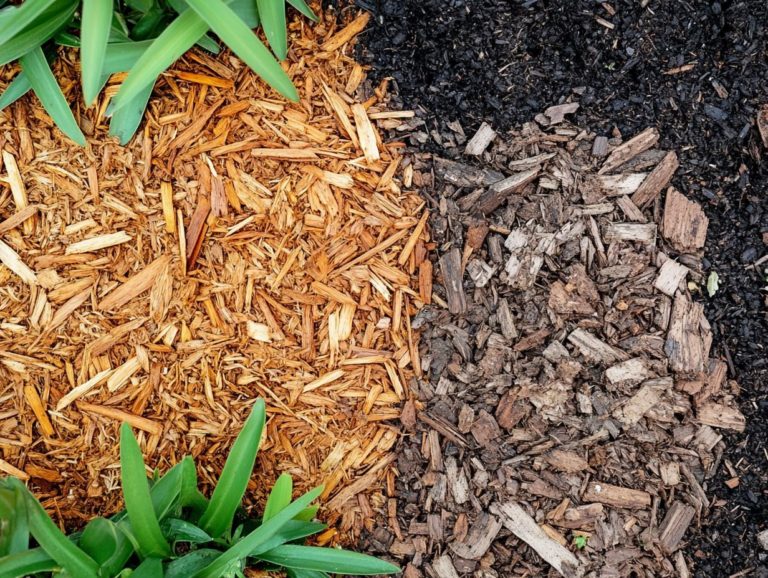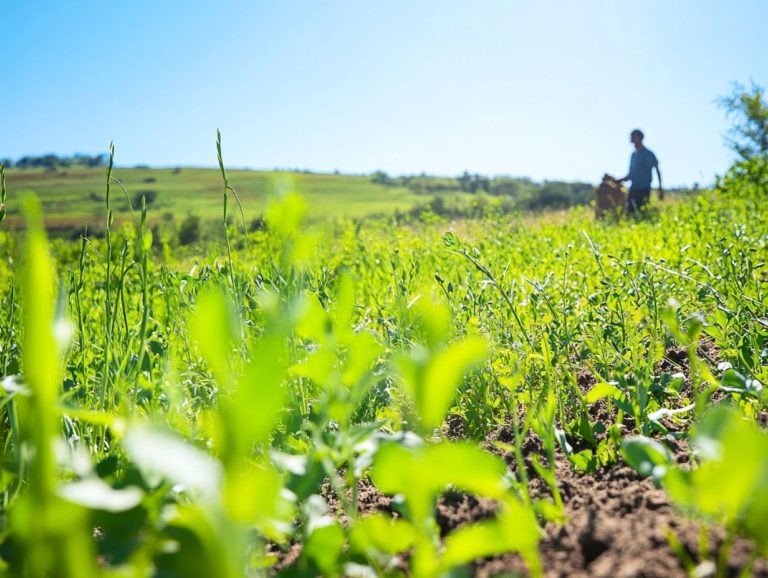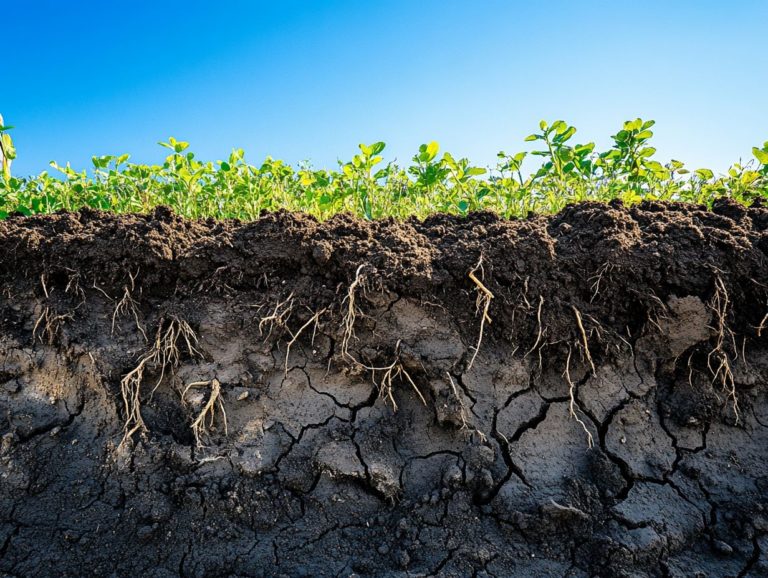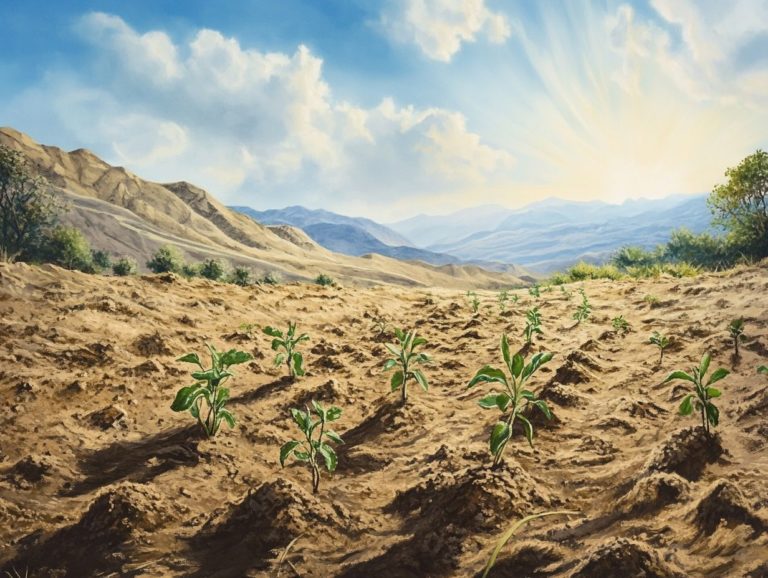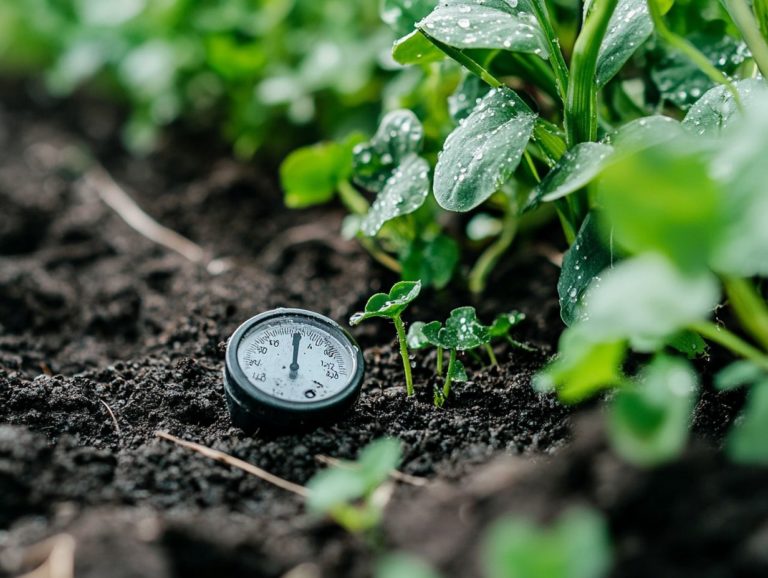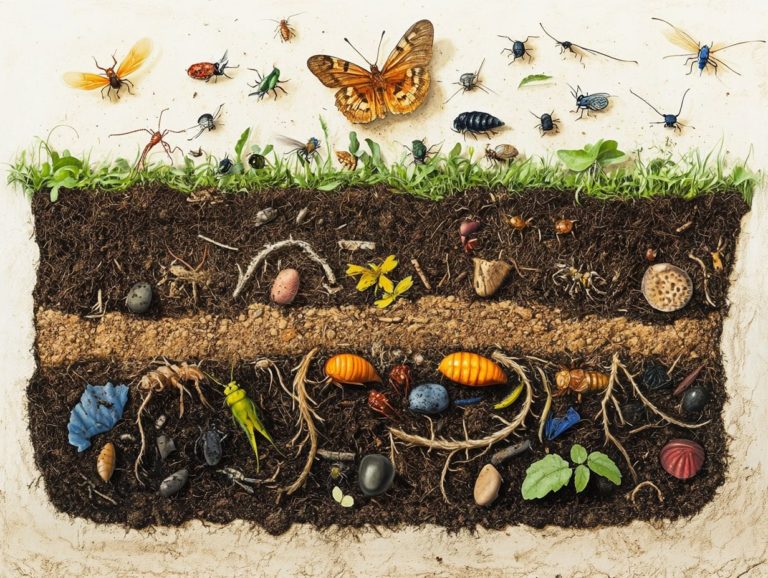Soil Conservation Methods for Sustainable Gardening
Soil conservation is crucial for cultivating a thriving garden and ensuring a healthy ecosystem. It incorporates sustainable methods that benefit the overall environment.
As you embark on this journey of understanding the importance of protecting soil management, you will discover essential principles of sustainable gardening. This blends traditional methods with modern innovations, including climate change considerations.
From actionable strategies for incorporating soil conservation into your gardening routine, such as erosion control and moisture retention, to the many benefits of sustainable practices, this article is your gateway to nurturing both your plants and the environment!
Explore with us the fascinating realm of soil conservation and its indispensable role in the art of gardening. Here, biodiversity maintenance and the implementation of techniques like buffer strips can enhance soil quality.
Contents
- Key Takeaways:
- The Importance of Soil Conservation
- Principles of Sustainable Gardening
- Traditional Soil Conservation Methods
- Modern Soil Conservation Techniques
- Implementing Soil Conservation in Your Garden
- Benefits of Sustainable Gardening
- Frequently Asked Questions
- What is soil conservation?
- Why is soil conservation important for sustainable gardening?
- What are some common soil conservation methods for sustainable gardening?
- How does mulching help with soil conservation in sustainable gardening?
- What is crop rotation and how does it contribute to soil conservation in sustainable gardening?
- Are there any natural or organic soil conservation methods for sustainable gardening?
Key Takeaways:

- Soil conservation promotes healthy soil, vital for plant growth and biodiversity.
- Sustainable gardening principles include minimizing chemical use, reducing erosion, and improving soil health through composting and mulching.
- Traditional methods like crop rotation and contour plowing effectively prevent soil erosion, while modern techniques like no-till farming conserve soil and resources.
The Importance of Soil Conservation
Soil conservation stands as a fundamental practice that not only protects the environment but also significantly contributes to sustainable agriculture and the preservation of biodiversity.
In the face of mounting threats such as land degradation and chemical pollution, understanding the importance of soil management is vital for both farmers and eco-communities.
Embrace effective soil conservation strategies to combat soil erosion, enhance soil fertility, and foster a healthier living environment for generations to come.
Why is Soil Conservation Important for Gardening?
Soil conservation is essential for your gardening success. It influences the health of your plants, the sustainability of your practices, and the overall productivity of your garden.
By embracing sustainable agriculture techniques, you can enhance soil structure, promote organic farming, and minimize chemical pollution, creating a vibrant and productive gardening environment.
Implementing practices like crop rotation the practice of alternating crops in a specific field prevents soil depletion and helps control pests. Incorporating green manure cover crops that enrich the soil and compost adds vital nutrients, fostering robust root systems and encouraging flourishing plant growth. Techniques such as chemical-free farming empower you to cultivate healthier ecosystems, ensuring that beneficial organisms thrive.
By prioritizing soil health with these sustainable methods, you can enjoy improved yields, healthier plants, and a thriving garden that beautifully harmonizes with nature.
Principles of Sustainable Gardening
The principles of sustainable gardening center on cultivating a balanced ecosystem that enhances soil health, fosters biodiversity, and optimizes the use of natural resources.
By adopting soil management techniques like incorporating organic matter and practicing crop rotation you can significantly contribute to eco-communities and embrace a sustainable approach to agriculture.
This mindful approach benefits your garden and nurtures the environment for future generations.
Begin implementing soil conservation techniques today and watch your garden thrive!
Key Concepts and Practices
Sustainable gardening relies on key concepts and practices. These include crop rotation, conservation tillage, and cover crops, all essential for managing soil and preventing erosion.
Incorporating nitrogen-fixing plants like peas or beans enriches the soil and reduces reliance on synthetic fertilizers. This fosters a healthier ecosystem.
Crop rotation involves alternating various types of crops in the same area throughout the seasons. This approach replenishes nutrients and disrupts pest cycles, effectively preserving soil structure.
Conservation tillage is a method that disturbs the soil less, helping to maintain precious organic matter crucial for soil health.
Consider planting cover crops like clover or rye during off-seasons. These protect the soil from erosion while enriching it with nutrients.
Traditional Soil Conservation Methods
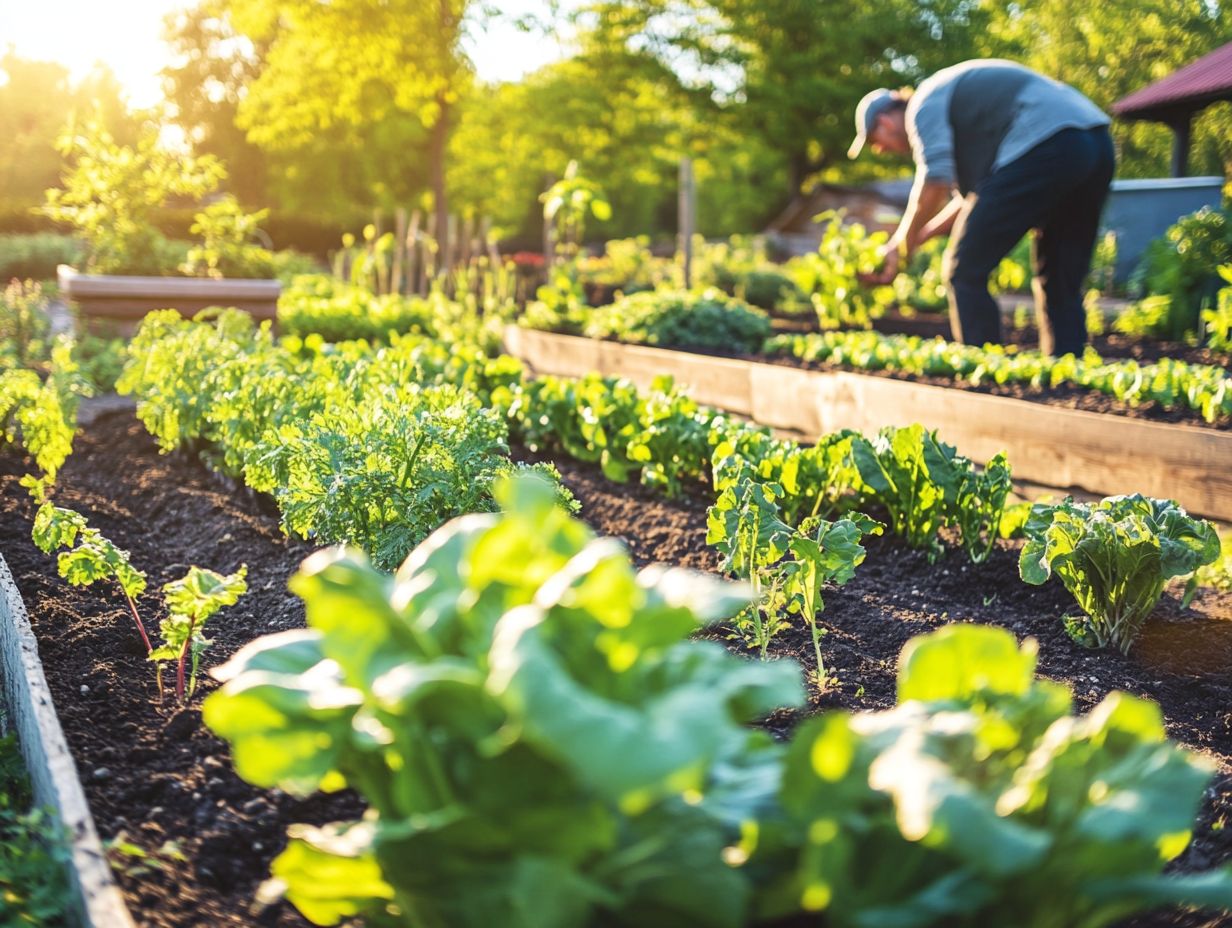
Discover how traditional soil conservation methods have supported farming for centuries! They protect our land and boost productivity.
Techniques like contour farming, strip cropping, and implementing windbreaks combat soil erosion while enhancing bank stabilization and improving water quality.
By embracing these practices, you re not just preserving the land; you re investing in its future.
Examples and Effectiveness
Examples of traditional soil conservation methods illustrate their effectiveness in controlling erosion and maintaining water quality. Practices like using vegetation cover for sediment control have been beneficial in sustainable agriculture.
Techniques such as contour plowing, which follows the natural contours of the land, and terracing, which creates steps on steep slopes, are recognized for minimizing runoff and enhancing water retention.
Strategically planting cover crops like clover or rye protects bare soil, increases organic matter, and fosters biodiversity.
In various contexts, especially in hilly or arid regions, these approaches lead to improved crop yields and a healthier ecosystem. They highlight the crucial role that such methods play in the future of sustainable farming practices.
Modern Soil Conservation Techniques
Modern soil conservation techniques harness advanced technologies and innovative practices to elevate soil management and tackle challenges like soil compaction and chemical pollution.
Utilizing tools such as EOSDA crop monitoring along with other agricultural monitoring systems provides valuable insights that guide sustainable farming practices.
New Technologies and Innovations
Emerging technologies, like high-resolution satellite images, play a pivotal role in modern soil management, offering detailed insights into soil health and moisture retention.
These innovations empower you to implement integrated pest management practices, creating natural filters that optimize agricultural output while minimizing environmental impact.
By capturing real-time data, satellite images allow monitoring of crop conditions and soil variations across vast farmland with precision.
This capability helps identify areas needing targeted interventions, ensuring efficient use of water and nutrients.
The advanced analytics from these images enhance predictive modeling for pest outbreaks, allowing for timely application of eco-friendly pesticides.
Integrating these technologies significantly boosts your soil conservation efforts, promoting sustainable farming practices that enhance productivity while safeguarding vital ecosystems and biodiversity.
Implementing Soil Conservation in Your Garden
Implementing soil conservation in your garden means protecting the ground to keep it healthy for growing plants. It involves a range of practical tips and strategies designed to enhance soil quality and promote sustainable practices.
Techniques like conservation tillage and the strategic use of cover crops can greatly improve moisture retention and overall soil health. This fosters a thriving garden environment that supports biodiversity. By adopting these methods, you not only enrich your soil but also contribute to a more sustainable ecosystem in your own backyard.
Practical Tips and Strategies
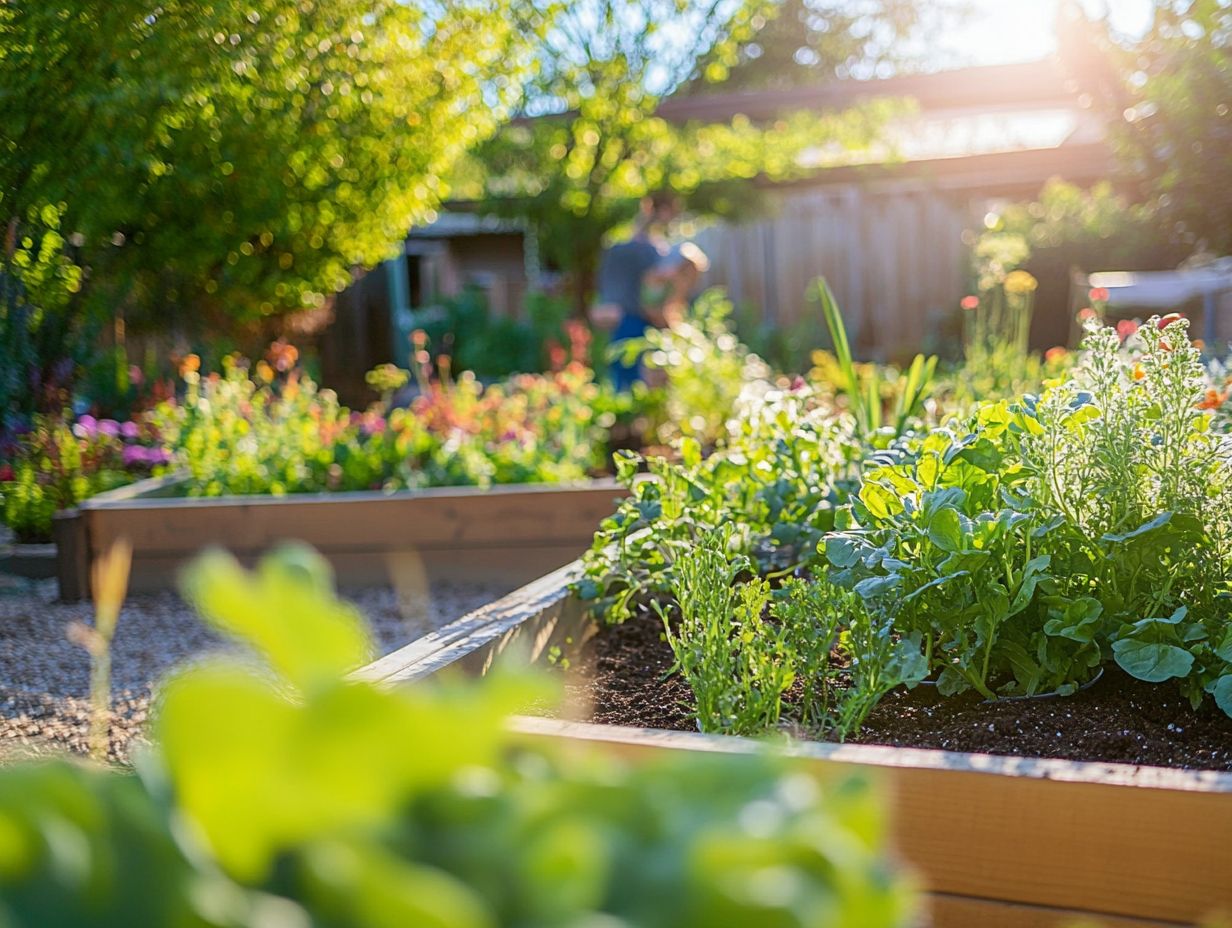
Consider incorporating practical tips and strategies that can make a significant difference in your agricultural practices. Techniques such as the use of drop inlets and grassed waterways improve erosion control.
Utilizing plants that help the soil by making nitrogen available, setting up buffer strips, and implementing grassed waterways can effectively manage water flow and improve soil fertility.
Incorporate crop residues into your soil for better quality and structure.
Nitrogen-fixing plants, such as clover and legumes, convert atmospheric nitrogen into forms that other crops can readily access. This reduces your reliance on synthetic fertilizers. By implementing buffer strips areas of vegetation planted along waterways you create natural barriers that trap sediments and nutrients. This helps to minimize erosion and runoff while improving water quality.
Grassed waterways serve as channels to redirect excess water, preventing soil erosion while ensuring moisture levels are maintained for surrounding areas. Practices like erosion control and water infiltration improve soil health and encourage biodiversity, leading to a more resilient and productive ecosystem overall.
Benefits of Sustainable Gardening
Sustainable gardening offers exciting benefits that go beyond just looking good; they encompass vital environmental and health benefits crucial for a flourishing ecosystem, including soil management and biodiversity maintenance.
By adopting sustainable methods and embracing chemical-free farming practices, such as organic farming, you actively contribute to biodiversity and foster a healthier environment for both plants and wildlife.
Environmental and Health Benefits
The environmental and health benefits of sustainable gardening are truly profound. By enhancing soil fertility and supporting biodiversity, you can minimize chemical pollution and create a healthier living environment for both yourself and nature.
Implementing techniques such as composting, crop rotation, and the use of nitrogen-fixing plants will enrich the nutrient content of your soil, fostering more resilient ecosystems. This approach, including practices like conservation tillage, encourages the flourishing of diverse plant and animal species while lessening your reliance on harmful pesticides and fertilizers, resulting in a cleaner environment.
By embracing natural pest control methods and attracting beneficial insects, your sustainable gardening practices contribute to maintaining a balanced ecosystem. The interconnected benefits ultimately lead to healthier food production, improving your well-being while safeguarding our precious natural resources and enhancing water quality.
Frequently Asked Questions
What is soil conservation?
Soil conservation is the practice of preventing soil erosion, degradation, and depletion while maintaining its soil fertility and productivity for sustainable use in sustainable agriculture and gardening.
Why is soil conservation important for sustainable gardening?
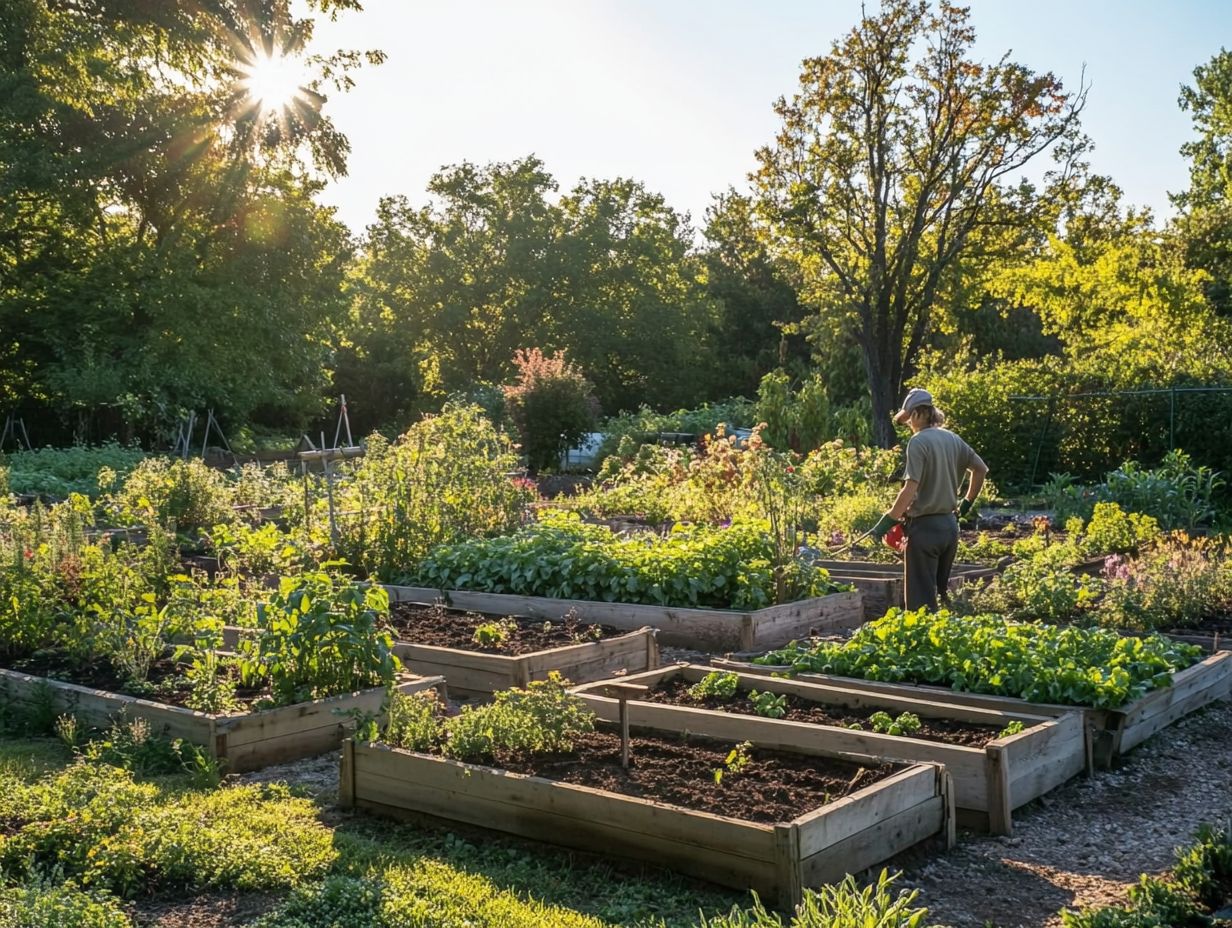
Soil conservation is crucial for sustainable gardening because it helps maintain the quality and health of the soil, which is essential for growing healthy plants. This ensures long-term productivity of the garden and combats land degradation.
Explore more about sustainable gardening to transform your space!
What are some common soil conservation methods for sustainable gardening?
Some common soil conservation methods for sustainable gardening include mulching, crop rotation, contour farming, terracing, and using cover crops. These techniques enhance moisture retention and reduce soil erosion. They help prevent soil erosion, improve soil quality, and increase water retention, contributing to better soil structure.
How does mulching help with soil conservation in sustainable gardening?
Mulching involves adding a layer of material, such as leaves or compost, on top of the soil. This protects the soil from erosion, retains moisture, and suppresses weeds, while also enhancing nutrient release from organic matter. As it decomposes, mulching adds nutrients to the soil, improving its overall health and fertility.
What is crop rotation and how does it contribute to soil conservation in sustainable gardening?
Crop rotation is the practice of growing different crops in the same area over time, rather than continuously planting the same crop. This approach helps control pests and improves soil fertility. Different crops have varying nutrient needs and can replenish the soil with their root systems. Crop rotation also helps prevent soil depletion and contributes to managing pests in a natural way.
Are there any natural or organic soil conservation methods for sustainable gardening?
Yes, many natural and organic soil conservation methods exist for sustainable gardening. These include using compost, manure, and green manure, which are all natural sources of nutrients for the soil. They also support buffer strips areas of vegetation along waterways that help prevent soil erosion. Other methods include crop rotation, intercropping, and using natural pest control methods instead of chemicals, promoting a reduction in pollution from agrochemicals. These practices maintain soil health without synthetic fertilizers and pesticides, making them environmentally friendly and beneficial for eco-communities.
Discover the secrets behind effective gardening! Start your sustainable gardening journey today by trying out these soil conservation techniques!

